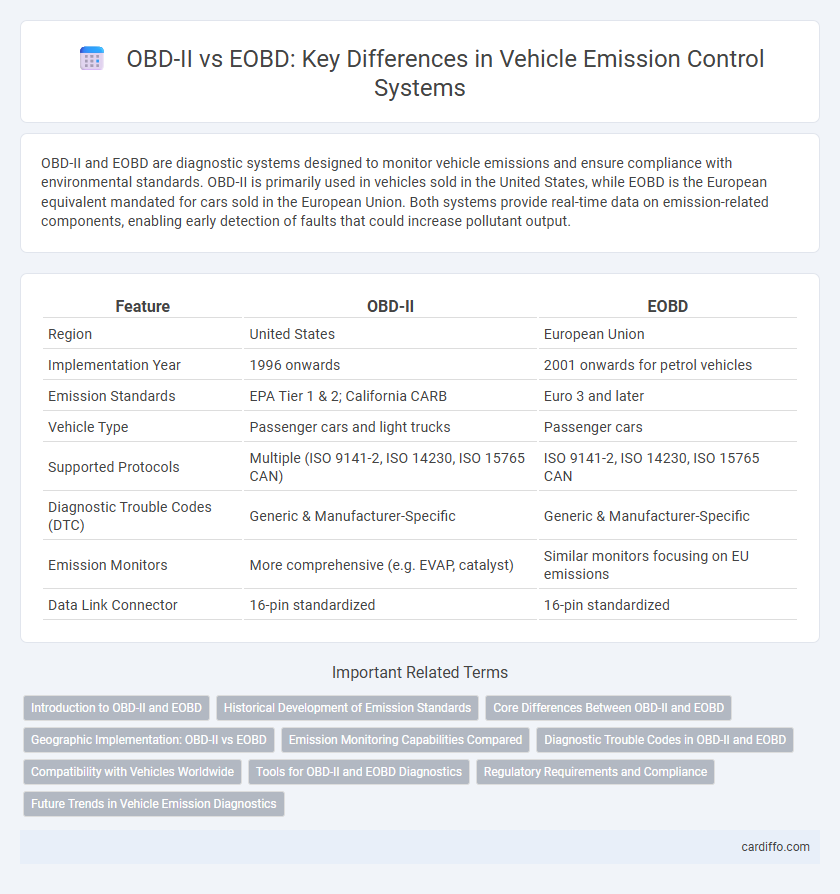OBD-II and EOBD are diagnostic systems designed to monitor vehicle emissions and ensure compliance with environmental standards. OBD-II is primarily used in vehicles sold in the United States, while EOBD is the European equivalent mandated for cars sold in the European Union. Both systems provide real-time data on emission-related components, enabling early detection of faults that could increase pollutant output.
Table of Comparison
| Feature | OBD-II | EOBD |
|---|---|---|
| Region | United States | European Union |
| Implementation Year | 1996 onwards | 2001 onwards for petrol vehicles |
| Emission Standards | EPA Tier 1 & 2; California CARB | Euro 3 and later |
| Vehicle Type | Passenger cars and light trucks | Passenger cars |
| Supported Protocols | Multiple (ISO 9141-2, ISO 14230, ISO 15765 CAN) | ISO 9141-2, ISO 14230, ISO 15765 CAN |
| Diagnostic Trouble Codes (DTC) | Generic & Manufacturer-Specific | Generic & Manufacturer-Specific |
| Emission Monitors | More comprehensive (e.g. EVAP, catalyst) | Similar monitors focusing on EU emissions |
| Data Link Connector | 16-pin standardized | 16-pin standardized |
Introduction to OBD-II and EOBD
OBD-II (On-Board Diagnostics II) is a standardized system introduced in the mid-1990s to monitor vehicle emissions and ensure compliance with environmental regulations, primarily used in the United States. EOBD (European On-Board Diagnostics) is the European equivalent, designed to meet the European Union's emission standards and OBD requirements for petrol and diesel vehicles. Both systems provide real-time data and diagnostic trouble codes to detect emission-related malfunctions, enabling effective vehicle emission control and maintenance.
Historical Development of Emission Standards
OBD-II (On-Board Diagnostics II) was introduced in the mid-1990s in the United States to monitor vehicle emission systems and ensure compliance with stricter EPA standards. EOBD (European On-Board Diagnostics) followed in 2001, adapting OBD-II protocols to meet the Euro emissions standards applicable across European Union member states. The historical development of these systems reflects a global shift toward tighter emission controls and standardized diagnostic requirements for vehicles.
Core Differences Between OBD-II and EOBD
OBD-II (On-Board Diagnostics II) and EOBD (European On-Board Diagnostics) differ primarily in regulatory scope and emission standards compliance, with OBD-II mandated in the United States and EOBD required in the European Union for gasoline vehicles. EOBD focuses on monitoring European emission limits such as Euro 3 and beyond, while OBD-II adheres to U.S. EPA regulations and California Air Resources Board standards. Both systems provide standardized diagnostic trouble codes (DTCs) and real-time data but vary in communication protocols, sensor requirements, and reporting thresholds aligned with regional emissions legislation.
Geographic Implementation: OBD-II vs EOBD
OBD-II is primarily implemented in vehicles sold in the United States, mandated since 1996 to monitor emissions and diagnose engine issues. EOBD applies to gasoline vehicles in the European Union, enforced from 2001, with similar emission standards but tailored to EU regulations. Both systems facilitate emission compliance but are geographically distinct due to regulatory frameworks in North America and Europe.
Emission Monitoring Capabilities Compared
OBD-II and EOBD systems both monitor vehicle emissions but differ slightly in regulatory scope and diagnostic parameters, with OBD-II used primarily in the United States and EOBD in Europe. OBD-II mandates comprehensive emission monitoring including oxygen sensors, evaporative systems, and catalytic converters, enabling detailed detection of emission-related faults. EOBD also focuses on reducing pollutants by monitoring similar emission components but incorporates specific criteria aligned with European emission standards such as Euro 5 and Euro 6.
Diagnostic Trouble Codes in OBD-II and EOBD
OBD-II and EOBD systems both utilize Diagnostic Trouble Codes (DTCs) to identify specific emissions-related issues in vehicles, with OBD-II primarily used in the United States and EOBD in Europe. While OBD-II codes follow a standardized format defined by SAE, EOBD codes align closely with this structure but may include regional variations to meet European emission standards. Both systems facilitate emissions monitoring by providing clear, standardized codes that enable efficient diagnosis and repair of emission control system malfunctions.
Compatibility with Vehicles Worldwide
OBD-II is a standardized onboard diagnostic system primarily used in vehicles sold in the United States since 1996, ensuring broad compatibility with American models. EOBD, the European equivalent, applies to petrol vehicles from 2001 and diesel vehicles from 2004 across EU countries, aligning emission standards with European regulations. While both systems share core diagnostic protocols, their compatibility varies by vehicle region, requiring specific interfaces for global emissions monitoring and maintenance.
Tools for OBD-II and EOBD Diagnostics
OBD-II and EOBD diagnostic tools are designed to interface with vehicle emission control systems to detect and report faults. OBD-II tools are compatible with most vehicles sold in the United States since 1996, while EOBD diagnostics apply to European vehicles from 2001 onward, focusing on emission-related fault codes and live data streaming. Advanced diagnostic scanners support standardized protocols like ISO 15765-4 (CAN) for efficient reading of emission parameters, stored codes, and readiness status in both OBD-II and EOBD systems.
Regulatory Requirements and Compliance
OBD-II and EOBD systems are both designed to meet stringent regulatory requirements for vehicle emissions monitoring and diagnostics. OBD-II is the standardized system mandated in the United States since 1996, ensuring compliance with EPA and CARB emissions regulations, while EOBD is the European equivalent required by the European Union to meet Euro 3 and later emissions standards. Both systems facilitate real-time emissions monitoring and fault detection to help vehicles comply with environmental laws and reduce harmful pollutants.
Future Trends in Vehicle Emission Diagnostics
OBD-II and EOBD systems are evolving to incorporate advanced emission diagnostic capabilities, leveraging real-time data analytics and cloud connectivity to enhance accuracy and compliance with stricter emission regulations worldwide. Integration of machine learning algorithms in these onboard diagnostics enables predictive maintenance and real-time emission control, reducing pollutants more effectively. Future trends emphasize seamless interoperability between OBD-II/EOBD platforms and smart city infrastructure, supporting comprehensive environmental monitoring and adaptive traffic management.
OBD-II vs EOBD Infographic

 cardiffo.com
cardiffo.com